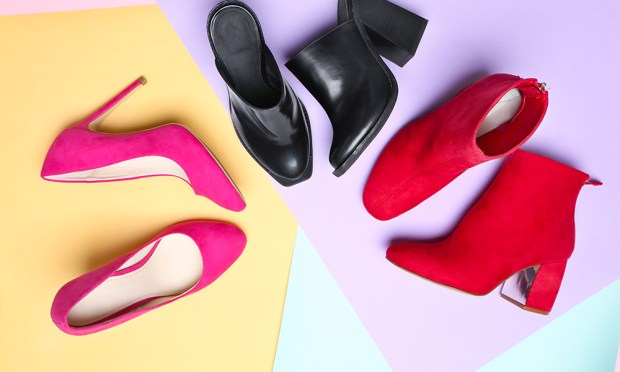Shoe Carnival: Selling Shoes Offline, Online And Everywhere In Between

Many eTailers, including Amazon with Zappos, are turning the nearly $100 billion footwear industry upside down — and creating serious competition for brick-and-mortar merchants. Kent Zimmerman, VP of digital for Shoe Carnival, gives PYMNTS the inside track on how the retailer is tapping in-store inventory to fulfill online orders more quickly, while using its mobile loyalty app to drive feet into the stores. Details in the latest issue of the Omni Usage Report.
It’s a great time to be a shoe seller.
The footwear industry is currently bringing in more than $83 billion annually in the United States alone, according to recent research — a more than 20 percent increase in revenue since 2010. That growth is not anticipated to slow, either, with industry projections showing it could become a $90 billion market by 2021.
As average Americans now spend 25 percent more on footwear than they did less than a decade ago, customers’ expectations have also grown in step. According to Kent Zimmerman, vice president of digital for retail chain Shoe Carnival, footwear fans now expect retailers to provide features that make shopping easier and more affordable, both online and off, and largely influenced by eCommerce warehouses like Amazon and Zappos.
In short, consumers expect retailers to be omni-ready. In fact, Zimmerman told PYMNTS in a recent interview that merchants that decide not to offer such features risk watching potential customers walk away in another seller’s shoes. Many will always choose to stop online, he acknowledged, but others will always choose to shop in stores.
“We want to reach those customers on whatever channel they prefer to use,” Zimmerman said.
Going mobile to boost in-store sales
In addition to its online store, Shoe Carnival currently operates more than 400 brick-and-mortar locations throughout the U.S. and Puerto Rico.
While online options like Zappos have become more popular among customers in recent years, Zimmerman noted many still prefer to make purchases at brick-and-mortar stores — and rightfully so. Recent research from the U.S. Census Bureau found 90 percent of retail transactions still happen at physical storefronts.
This gives Shoe Carnival an advantage over online-only sellers, and the company has worked to emphasize its in-store offering with recent tech integrations. That includes its new mobile loyalty app, which rolled out in summer 2017. The app is designed to reward consumers for browsing and buying footwear and other merchandise from brick-and-mortar stores, encouraging them to come back for another visit. It also includes other tech integrations and features like style recommendations based on purchase history.
“We know that a lot of our customers are using digital channels to inform their decision in-store,” Zimmerman said. “We wanted a mobile app that would make it easy for customers to get loyalty information, and hopefully engage with those customers enough with our app that it drives them to the store.”
Bringing online and offline together
But a mobile app isn’t the only way Shoe Carnival is utilizing tech to draw customers into physical stores. It’s also using its in-store inventory to fill online orders, a move to cut delivery times, give customers more in-store tools while and inspire store visits.
Because the company’s inventory is stored in brick-and-mortar locations rather than at a warehouse, items can be pulled up at a moment’s notice. Employees can then use that information to help in-store customers locate a size or style they want to purchase and better estimate delivery times. Shoe Carnival is also able to offer buy-online, pick-up-in-store delivery options for almost all online orders., which can bring customers in more often by promising quicker in-hand deliveries.
The company’s online presence doesn’t just aim to bring customers to its brick-and-mortar stores, however. Zimmerman emphasized that having an online store that can stand on its own — without hurting sales at physical locations — is essential in the digital age.
“The reality is, some people will migrate from an in-store customer to a digital customer, [and] there’s nothing we can do to avoid that,” he said. “If you try too hard to push online shoppers into stores with pricing or features, they may just go to Amazon or some other online seller, because that customer just wants to buy online. So for us, it’s about giving them a consistent experience no matter where they shop.”
Omni days to come
As consumers continue to shop more frequently through online and mobile channels, Shoe Carnival is planning to keep pace with new tech integrations and features.
It is currently working to develop a new version of its mobile app, with plans to offer in-app mobile payments to give customers easier and more convenient ways to pay for purchases. Down the road, Shoe Carnival is also hoping to add in-store mobile payment acceptance, Zimmerman added.
The company is also working to use its wealth of in-store inventory to fuel other pick-up and delivery options for consumers, including options like curbside pick-up or same-day local delivery. These would mirror offerings like Target’s curbside pick-up and Amazon’s same-day option, helping Shoe Carnival keep up with rising customer expectations surrounding online order delivery.
“Anything we can do to decrease friction for our customers is something we want to do and is a high priority for us,” Zimmerman said.
After all, if merchants want customers to walk many miles in their shoes, they’ll need to give them the features they want — or watch them walk straight to a competitor’s doors.
About The Tracker
The Omni Usage Report™, a PYMNTS.com and Vantiv collaboration, features industry-spanning research and insights that arm retailers with data to make smarter decisions for enabling omnichannel commerce.

